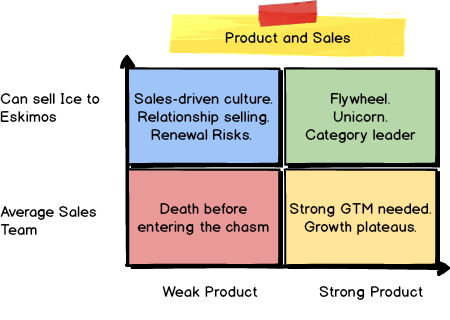Some SaaS ventures lead to category leadership while some lead to imaginary frozen quadrants. Here’s a little 2X2 to assess where you are in your journey to SaaS nirvana. When amazing products are sold in amazing ways, it produces the almost mystical flywheel effect.
Let’s dissect this.
Red: Weak Product and a Weak/Average Sales Team
This is a highly incremental quadrant where a single provider may be serving the exact needs of a handful of customers. It’s an equilibrium that doesn’t last too long. I’ll leave this quadrant at that.
Blue: Weak Product and a Strong Sales Team
When people say “that company is sales driven” this is what they are referring to. Founders of companies in this quadrant have a knack of story-telling and projecting a product market fit before a product is actually ready. What happens next is catastrophic. Sales drives the company’s culture, narrative, and product building. Both product and engineering go into a wild-balancing act of fixing the problems while trying to add features in a near random fashion.
It is unsustainable. It bloats customer service, support, and pre-sales. Lack of a strong product causes politicking, confusion, and populism in every department, which leads to relationship-driven rather than value-proposition driven outcomes. Unless a startup iterates on product rapidly or brings in a disciplined and creative leader, there’s a significant risk of revenues plateauing at $5m-$10m mark.
So why is it blue? Because it is fairly cushioned for a while though sales > everything is bad karma.
Yellow: Strong Product and a Weak/Average Sales Team
This quadrant probably causes hackers amongst us the most heartburn. A lot of strong products start with nobody focused on sales. They continue to write amazing code, design amazing screens, and setup amazing data pipelines, but they just don’t know how to position, craft a story people remember, distinguish themselves from 99 other guys who may have had the same idea. Many product founders suck at sales and often hire the first person who blinks.
Even for successful startups, this can be a transient stage, but successful founders realize their mistakes and then quickly hire a sales leader and move to the next quadrant. The good news if you’re yellow is that just like in real life, you can cross the traffic light before too much damage happens.
Green: Strong Product and Strong Sales Team
This is jazz improvisation zone. You can have a strong product and sales culture. It all starts with respect for both and it certainly involves finding the right talent that can craft what really works uniquely for you.
That’s why very few founders get there. A scalable sales model is crucial. A product alone can take you so far. For every Dheeraj Pandey ringing the IPO bell, there’s a Sudheesh Nair driving the quota home. For every Jyoti Bansal getting acquired at $3.7bn, there’s a Dali Rajic digging into sales capacity, and for every Jason Lemkin, there’s a Brendon Cassidy. When phenomenal founders and product builders pair up with their sales counterparts, to accomplish a sight to behold – a startup on a flywheel across the sky.
In each of these cases, the sales counterparts were able to hit their targets, because of a product which was able to either create demand or was superior to incumbents. If there was a product market fit, based on the narrative, the product scaled to bring in a perpetual stream of renewals and sources of new revenue.
Hopping in the 2×2
I hope you’ve found your color by this point. So how do we transition from a shitty part of the quadrant to an awesome one?
If you are Blue or Yellow, scale to Green quick. Here are some things that increase your chances in a hop
- Listen to early feedback from customers and employees and suppliers. Setup key feedback loops
- Iterate the product every week, every day, every hour. Continuous Beta. A living element
- Once you cross $10 million, press the gas pedal. Go. Go. Go
Good luck and let me know if you think of additional colors.
Thanks to Leena for flywheeling this post!

 way. The dream could be a INR 100 crore product or something as complex as an ERP on the web to a even more complicated, a Hospital Information Systems (.. search engines? they are easier to build these days).
way. The dream could be a INR 100 crore product or something as complex as an ERP on the web to a even more complicated, a Hospital Information Systems (.. search engines? they are easier to build these days).